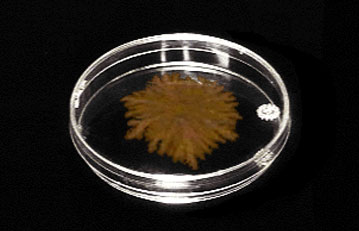
5.1 - Bacterial Colonies

HandsOn Activities:
In this section you will study shapes of bacterial colonies grown under various nutrient conditions. The primary questions are these: Why are the shapes of bacterial colonies grown under starvation conditions similar to patterns of non-living systems, such as electrochemical deposition and viscous fingering? Can we understand these shapes from our experience with random walks and diffusion?
The growth of bacterial colonies reflect a current research question: Does the growth pattern of the colony result from purposeful collective social behavior by the bacteria? Or can it be explained by the physics of random processes (as with a random walker model)? You will reach your own conclusions about whether the bacterial colony shapes you obtain are determined primarily by simple physics, or whether social interactions among the bacteria are necessary to create the observed patterns.
Standard
laboratory practice is to grow a bacterial colony on a flat gelatinous
surface with a rich source of nutrition. In this experiment, by
contrast, the bacterial colonies are grown under varying nutritional
conditions that approach the starvation threshold. The gel resides
in a round flat dish (a standard petri dish) about 9 centimeters
in diameter. To start growing the colony, you should put a small
drop of bacteria in the center of the gel. Then you cover the petri
dish and place it in an incubator at a standard temperature and
study the pattern of the colony as it grows outward over a period
of days and weeks.
|
What happens when the bacteria are forced to grow in starvation
conditions? Can they hunt for food? What determines whether they
receive nutrition? Do bacteria cooperate among themselves? What
determines the shape of the colony? What shape is optimal for survival?
Is the shape we see the optimal one? And what about the nutrients?
Do they remain stationary in the gel waiting for the bacteria to
come and graze? Or do they diffuse through the gel to areas of low
concentration where bacteria have eaten the nutrients?
|
There is, of course, an innate tendency to think differently about
living organisms than about "dead'' objects. But now we are
well aware that non-living materials can grow into beautiful, elaborate
patterns. So here are some more questions:
|
When you did the electrodeposition experiment, you probably had
an internal mental model for what was happening. You "imagined''
copper ions moving through solution. You "pictured'' them attaching
to the growing aggregate and being reduced (i.e., adding two electrons).
You reasoned about the applied electric field and its ability to
drive ions through the solution, and electrons through the external
circuit. And when you compared your results to those of the Aggregation
Kit simulation, you drew analogies between the simulation and
the experiment.
In order to build a mental model to analyze the bacteria experiment, you need certain facts about bacteria and their behavior. You may also find it useful to adopt some of the code words scientists use to discuss these experiments. These words include:
Among the bacteria we recommend for this experiment are Bacillus subtilis (B. subtilis ), Escherichia coli ( E. coli ), and Enterobacter aerogenes (E. aerogenes ). All are rod-like in shape with dimensions 2-3 micrometers (mm) in length and 1 mm in width. They occur commonly, are usually found in the human digestive tract, soil, and unpasteurized dairy products. To grow B. subtilis and E. coli you need to incubate the agar plates at 37°C. E. aerogenes grows at room temperature. Typically all three strains of bacteria multiply every 20 minutes if adequate nutrition is available.
Bacteria respond differently to starvation conditions. B. subtilis retreats into a dormant mode by forming endospores, thick-coated cells that can withstand conditions that would quickly kill the normal active cell. In contrast, E. Coli and E. aerogenes die.
The wild strain of each of these bacteria (i.e., the most commonly observed strain in nature) is motile - it moves. Each is flagellated, that is, has various numbers of little whip-like arms. Under a microscope, bacteria growing on agar near the colony look like many tadpoles swimming randomly. It is not far-fetched to describe each bacterium as executing a random walk, one restricted to the neighborhood of the colony. Bacteria also excrete a fluid which can enhance their ability to move on the agar surface.
In our experiments, nutrients are supplied to bacteria by dispersing them in a gelatin-like material made from agar. Agar is a long-chain molecule made from seaweed. When dissolved in water at sufficiently high concentrations, it causes the solution to gel. In this way, agar is much like gelatin. Nutrient molecules diffuse through agar gel nearly as quickly as through water.
Bacteria respond to chemical signals. One famous example is that of slime mold. Under starvation conditions the bacteria release chemicals that result in a chemotactic response: the bacteria come together into a single colony and form a spherical growth called a fruiting body to survive the adverse conditions. (In biology taxis -pronounced "tax-iss''-refers to motion by an organism in response to a stimulus. Chemotaxis is motion in response to a chemical stimulus. Phototaxis is motion in response to light. These terms are similar to chemotropism and phototropism; however a tropic response can include growth as well as motion.)
While it is known that bacteria communicate chemically, it is difficult to isolate the chemicals they use, or to distinguish purposeful organization resulting from this chemical communication. As an example of the distinction: in electrochemical deposition, beautiful patterns emerge as the ions aggregate; moreover, the atoms "communicate'' chemically. In spite of this, we do not say that copper atoms behave socially!